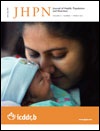Risk Factors of Rheumatic Heart Disease in Bangladesh: A Case-Control Study
DOI:
https://doi.org/10.3329/jhpn.v31i1.14751Keywords:
Case-control study, Rheumatic fever, Rheumatic heart disease, Risk factors, BangladeshAbstract
Not all cases of rheumatic fever (RF) end up as rheumatic heart disease (RHD). The fact raises the possibility of existence of a subgroup with characteristics that prevent RF patients from developing the RHD. The present study aimed at exploring the risk factors among patients with RHD. The study assessed the risk of RHD among people both with and without RF. In total, 103 consecutive RHD patients were recruited as cases who reported to the National Centre for Control of Rheumatic Fever and Heart Disease, Dhaka, Bangladesh. Of 309 controls, 103 were RF patients selected from the same centre, and the remaining 206 controls were selected from Shaheed Suhrawardy Medical College Hospital, who got admitted for other non-cardiac ailments. RHD was confirmed by auscultation and colour Doppler echocardiography. RF was diagnosed based on the modified Jones criteria. An unadjusted odds ratio was generated for each variable, with 95% confidence interval (CI), and only significant factors were considered candidate for multivariate analysis. Three separate binary logistic regression models were generated to assess the risk factors of RF, risk factors of RHD compared to non-rheumatic control patients, and risk factors of RHD compared to control with RF. RF and RHD shared almost a similar set of risk factors in the population. In general, age over 19 years was found to be protective of RF; however, age of the majority (62.1%) of the RHD cases was over 19 years. Women [odds ratio (OR)=2.2, 95% CI 1.1-4.3], urban resident (OR=3.1, 95% CI 1.28.4), dwellers in brick-built house (OR=3.6, 95% CI 1.6-8.1), having >2 siblings (OR=3.1, 95% CI 1.5- 6.3), offspring of working mothers (OR=7.6, 95% CI 2.0-24.2), illiterate mother (OR=2.6, 95% CI 1.2-5.8), and those who did not brush after taking meals (OR=2.5, 95% CI 1.0-6.3) were more likely to develop RF. However, more than 5 members in a family showed a reduced risk of RF. RHD shared almost a similar set of factors in general. More than three people sharing a room also showed an increased risk of RHD (OR=1.9, 95% CI 1.0-3.4), in addition to the risk factors of RF. Multivariate model also assessed the factors that may perpetuate RHD among RF patients. Overcrowding (OR=2.4, 95% CI 1.2-4.7) and illiteracy (OR=2.4, 95% CI 1.1-5.2) posed the risk of RHD in the RF patients. The study did not find new factors that might pose an increased risk, rather looked for the documented risk factors and how these operate in the population of Bangladesh.
J HEALTH POPUL NUTR 2013 Mar;31(1):70-77
Downloads
365
298

